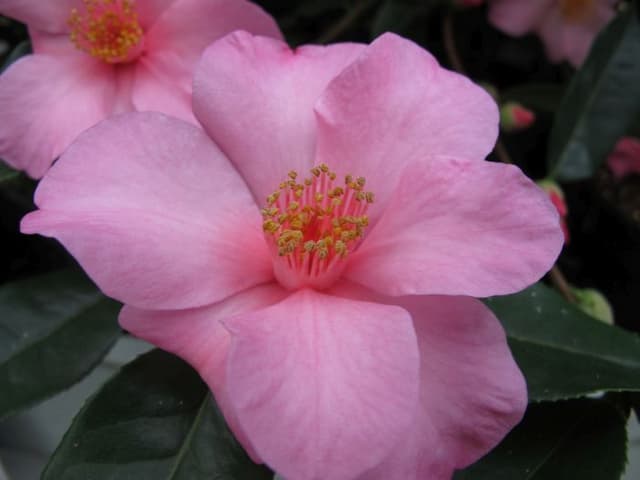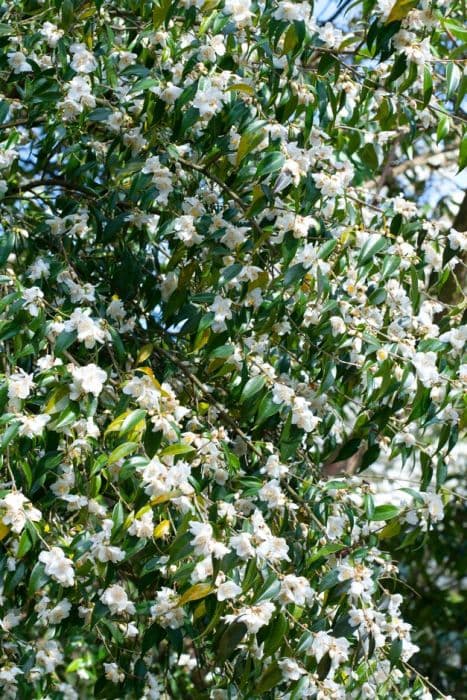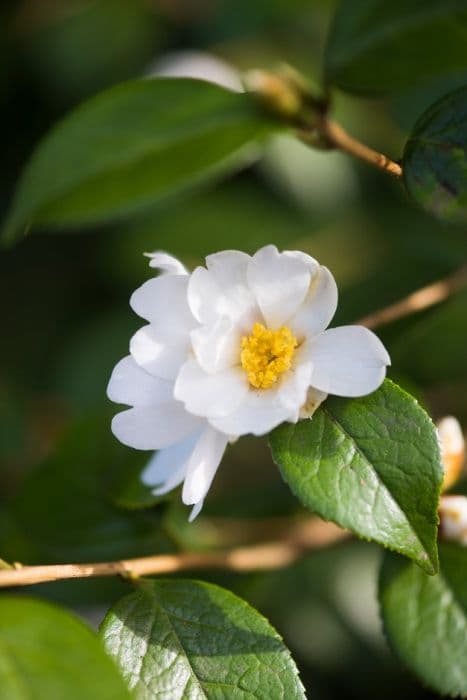Japanese Camellia Camellia japonica 'Masayoshi'

ABOUT
Camellia japonica 'Masayoshi' exhibits a refined and attractive appearance that often makes it a favorite among garden enthusiasts. The most distinctive feature of this plant is its flowers. They are quite large and possess an alluring form that can range from a semi-double to a peony-like shape. The petals color is a deep, rich pink that tends to be eye-catching. These flowers make a dramatic display when they bloom against the glossy, dark green foliage that is typical of the species. The leaves of 'Masayoshi' are leathery with a smooth, almost burnished quality, and they grow in a dense, evergreen formation which allows the plant to look attractive throughout the year, long after the blooming season has finished. The overall form of 'Masayoshi' is upright and it typically presents a bushy and well-branched habit, which contributes to its lush, full appearance. Aside from its blossoms and foliage, the plant may also produce fruit that is dry and not ornamentally significant. Despite this, gardeners primarily cultivate 'Masayoshi' for its stunning floral display and its foliage that provides year-round interest in the landscape.
About this plant
 Names
NamesFamily
Theaceae
Synonyms
Japanese Camellia, Rose Of Winter, Tsubaki
Common names
Camellia japonica 'Masayoshi'.
 Toxicity
ToxicityTo humans
Camellia japonica, commonly known as the Japanese camellia, is not considered toxic to humans. In general, ingestion of this plant is unlikely to cause serious harm, but it is always advisable to avoid eating plants not intended for consumption. There are no well-documented toxic effects or symptoms associated with ingestion of the Japanese camellia for humans.
To pets
The Japanese camellia is not considered toxic to pets. It is unlikely that ingestion of the plant will cause any significant symptoms of poisoning in animals such as dogs or cats. As with humans, it is generally advisable to prevent pets from consuming plants not meant for their diet, but consumption of this plant typically does not result in serious consequences for pets.
 Characteristics
CharacteristicsLife cycle
Perennials
Foliage type
Evergreen
Color of leaves
Green
Flower color
Pink
Height
6-10 feet (1.8-3 meters)
Spread
5-7 feet (1.5-2.1 meters)
Plant type
Shrub
Hardiness zones
7
Native area
Japan
Benefits
 General Benefits
General Benefits- Aesthetic Appeal: Camellia japonica 'Masayoshi', commonly known as the Japanese Camellia, features beautiful, large pink flowers that can enhance the visual appeal of any garden.
- Year-Round Foliage: Its evergreen leaves provide a lush green backdrop throughout the year, even in winter when other plants may lose their leaves.
- Landscape Versatility: Japanese Camellia is versatile and can be used for hedges, screens, or as a stand-alone specimen in landscapes.
- Shade Tolerance: It performs well in partial shade, making it a good option for under-canopy planting or in areas with dappled sunlight.
- Low Maintenance: Japanese Camellia is generally low maintenance, requiring minimal pruning and care once established.
- Wildlife Attraction: The blossoms can attract pollinators such as bees and butterflies, contributing to the ecological health of a garden.
- Drought Tolerance: Once established, it has a degree of drought tolerance, making it suitable for gardens in regions that experience dry spells.
- Long Blooming Period: The bloom time extends from winter into spring, providing color during a time when many other plants do not flower.
- Cultural Significance: The Japanese Camellia has cultural importance in Japan and other East Asian countries, where it is often associated with good fortune and used in traditional gardens.
 Medical Properties
Medical PropertiesThis plant is not used for medical purposes.
 Air-purifying Qualities
Air-purifying QualitiesThis plant is not specifically known for air purifying qualities.
 Other Uses
Other Uses- Art and Crafts: The dried petals of Camellia can be used in crafting, such as for making jewelry, bookmarks, or as natural confetti for eco-friendly events.
- Dye: The petals can also be used to make natural dyes for fabrics, providing a variety of hues based on the color of the petals used.
- Photography: Camellia flowers often serve as stunning subjects or backdrops in photography due to their vibrant colors and beautiful form.
- Garden Design: Pruned branches and foliage can be used in garden design to create natural barriers or to enhance the aesthetics of garden beds.
- Religious Ceremonies: In some cultures, Camellia is used as a part of religious ceremonies and offerings due to their significance and beauty.
- Education: Camellia plants can be used as educational tools in botanical studies to illustrate plant growth, reproduction, and care.
- Cooking: Some parts of the Camellia such as leaves can be used in culinary arts, especially in exotic recipes, although not commonly consumed.
- Livestock Feed: Although not a primary choice for feed, in some regions, the leaves and petals may be used as feed for livestock when other food sources are scarce.
- Companion Planting: Camellia can be planted alongside other plants to create symbiotic relationships, helping with pest control and pollination.
- Decoration: Fresh flowers are often used in decoration for events and ceremonies, while the glossy, dark green leaves can be utilized in floral arrangements.
Interesting Facts
 Feng Shui
Feng ShuiCamellia is not used in Feng Shui practice.
 Zodiac Sign Compitability
Zodiac Sign CompitabilityCamellia is not used in astrology practice.
 Plant Symbolism
Plant Symbolism- Admiration: Camellias often symbolize deep respect and admiration, which can be linked to their showy and elegant blooms. 'Masayoshi' with its exquisite flowers continues this tradition.
- Perfection: The perfect form of Camellia blossoms can represent the idea of ideal beauty or striving for perfection.
- Love: Giving a Camellia is associated with expressing romantic interest, love, or affection.
- Longevity: Because Camellias can live for many years, they're commonly associated with long life and endurance.
- Gratitude: A Camellia bouquet can symbolize gratitude, making it a popular gift to show appreciation.
 Water
WaterThe Japanese Camellia 'Masayoshi' prefers consistent moisture but it does not like to be waterlogged. Watering should be done deeply when the top inch of soil feels dry to the touch, which could be once a week or more during dry spells. Avoid shallow watering in favor of a thorough soak, which could amount to around 1-2 gallons depending on the size of the plant and weather conditions. During the winter, reduce watering frequency as the plant requires less moisture. Ensure that the plant has adequate drainage to prevent root rot.
 Light
LightJapanese Camellias such as 'Masayoshi' need a spot with bright, indirect light or partial shade. Direct sunlight, especially in the hot afternoon, can scorch the leaves, so morning sunlight or filtered light is ideal. An eastern or northern exposure that shields the camellia from the intense afternoon sun will create the optimal lighting conditions.
 Temperature
TemperatureJapanese Camellias 'Masayoshi' thrive in a temperature range of roughly 40 to 85 degrees Fahrenheit. They can survive minimum temperatures down to about 20 degrees Fahrenheit but should be protected from harsh winter winds. The ideal temperature range for promoting flower bud formation is between 50 and 70 degrees Fahrenheit.
 Pruning
PruningPrune the Japanese Camellia 'Masayoshi' to maintain its shape and remove any dead or weak growth, enhancing overall plant vigor. The best time for pruning is just after blooming has finished in the late winter or early spring. You generally won't need to prune every year; doing so every two to three years is often sufficient unless shaping or size reduction is necessary.
 Cleaning
CleaningAs needed
 Soil
SoilJapanese Camellias thrive in well-draining, acidic soil with a pH between 5.5 and 6.5. A mix of peat moss, fine bark, and perlite or sand is ideal. Ensure the soil stays moist but not waterlogged.
 Repotting
RepottingJapanese Camellias should be repotted every 2-3 years or when they outgrow their pot. Spring is the best time for repotting to minimize stress on the plant.
 Humidity & Misting
Humidity & MistingJapanese Camellias prefer a humid environment around 40-50% humidity. They thrive outdoors in the right climate or indoors with increased humidity levels.
 Suitable locations
Suitable locationsIndoor
Place in bright, indirect light and maintain high humidity.
Outdoor
Plant in partial shade with shelter from strong winds.
Hardiness zone
7-9 USDA
 Life cycle
Life cycleCamellia japonica 'Masayoshi', commonly known as the Japanese camellia, starts its life as a seed, requiring well-drained, acidic soil to germinate. Upon sprouting, the seedling grows into a small shrub, developing glossy green leaves and a strong root system. As it matures, the shrub enters a vegetative state where it focuses on growth and can reach several meters in height. Once the plant is mature enough to reproduce, it produces prolific, ornately ruffled pink flowers typically in late winter to early spring. Following pollination, which can occur via insects such as bees, the flowers give way to seed pods that mature by autumn, completing the reproductive cycle. The Japanese camellia is an evergreen, and with proper care, it can live for many years, even decades, continuing to grow and reproduce seasonally.
 Propogation
PropogationPropogation time
Spring-Early Summer
The Camellia, specifically the Camellia japonica 'Masayoshi', is best propagated through semi-hardwood cuttings. This method usually takes place during the late summer or early fall when the current year's growth has begun to mature and harden slightly. To propagate by this method, a gardener would take cuttings about 4 to 6 inches long with several leaves attached. The lower leaves are carefully removed and the cut end of the cutting is dipped into rooting hormone before being inserted into a pot filled with a mixture of peat and perlite or sand to ensure good drainage. The pot is then kept in a sheltered location with indirect light and maintained at a consistent moisture level. Rooting can take several months, after which the new Camellia plants can be transplanted into individual pots or directly into the garden.









